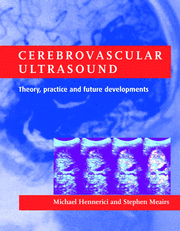Book contents
- Frontmatter
- Dedication
- Contents
- List of contributors
- Preface
- PART I ULTRASOUND PHYSICS, TECHNOLOGY AND HEMODYNAMICS
- PART II CLINICAL CEREBROVASCULAR ULTRASOUND
- (i) Atherosclerosis: pathogenesis, early assessment and follow-up with ultrasound
- 8 Morphogenesis of the atherosclerotic plaque
- 9 Hemodynamics and atherosclerosis
- 10 Carotid artery intima-media thickness
- 11 Non-invasive evaluation of endothelial function with B-mode ultrasound imaging of flow-induced brachial artery reactivity
- 12 Plaque characterization and risk profiles
- 13 Natural history of asymptotic carotid stenosis
- (ii) Extracranial cerebrovascular applications
- (iii) Intracranial cerebrovascular applications
- PART III NEW AND FUTURE DEVELOPMENTS
- Index
13 - Natural history of asymptotic carotid stenosis
from (i) - Atherosclerosis: pathogenesis, early assessment and follow-up with ultrasound
Published online by Cambridge University Press: 05 July 2014
- Frontmatter
- Dedication
- Contents
- List of contributors
- Preface
- PART I ULTRASOUND PHYSICS, TECHNOLOGY AND HEMODYNAMICS
- PART II CLINICAL CEREBROVASCULAR ULTRASOUND
- (i) Atherosclerosis: pathogenesis, early assessment and follow-up with ultrasound
- 8 Morphogenesis of the atherosclerotic plaque
- 9 Hemodynamics and atherosclerosis
- 10 Carotid artery intima-media thickness
- 11 Non-invasive evaluation of endothelial function with B-mode ultrasound imaging of flow-induced brachial artery reactivity
- 12 Plaque characterization and risk profiles
- 13 Natural history of asymptotic carotid stenosis
- (ii) Extracranial cerebrovascular applications
- (iii) Intracranial cerebrovascular applications
- PART III NEW AND FUTURE DEVELOPMENTS
- Index
Summary
Introduction
The clear relationship between disease of the carotid bifurcation, transient ischemic attacks and strokes has been known for a considerable amount of time (Roederer et al., 1984; Clinical Advisory, 1994; NASCET, 1991; ECACAS, 1995). The debates that have emerged over the 1980s have centred largely on how to detect it and how and when it should be treated. While the development of contrast arteriography clarified to some degree what we needed to know, it had and has terrible shortcomings. There is no question about its potential for harm but, most importantly, its limitations as a ‘gold standard’ are now being realized. This form of testing has had some very interesting twists which need to be commented on (ECACAS, 1995; Chikos et al., 1983; Davies & Humphrey, 1993).
The desired form of imaging for many years was obtained by using cut-film, multiple views of the bulb, a look at the arch of the aorta and the intracranial circulation as well. This began to change when the digital techniques became popular, along with the rapid rise and fall of intravenous angiography. Suddenly, many of the standard views which were deemed necessary were no longer important or did not seem so. There is no evidence that the therapy of carotid artery disease – medical or surgical – suffered by this change in approach and attitude on the part of the physicians.
- Type
- Chapter
- Information
- Cerebrovascular UltrasoundTheory, Practice and Future Developments, pp. 184 - 190Publisher: Cambridge University PressPrint publication year: 2001



